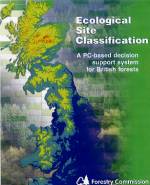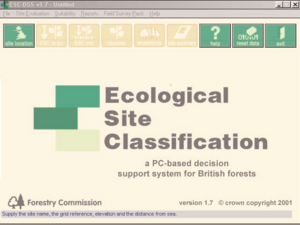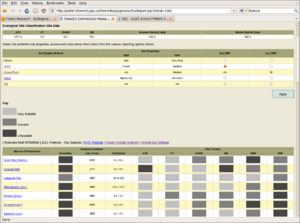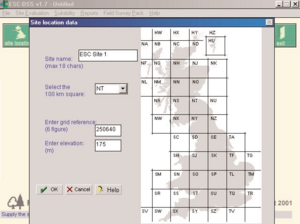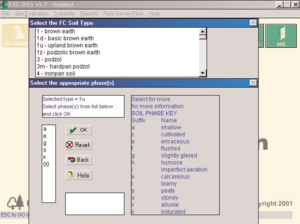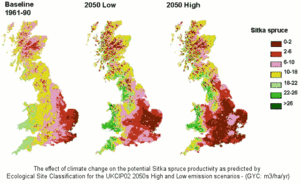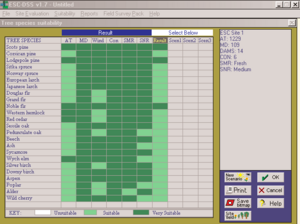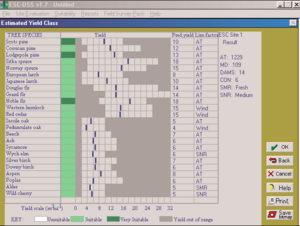Difference between revisions of "ESC"
m (noted implementation language for version 2) |
Ola Eriksson (Talk | contribs) |
||
| (6 intermediate revisions by 4 users not shown) | |||
| Line 8: | Line 8: | ||
ESC is a PC-based DSS that supports a methodology for the evaluation of the suitability of different tree species and woodland communities as defined in the National Vegetation Classification (NVC) for Great Britain, and also predicting yield in the form of a site index, on the UK forest land. | ESC is a PC-based DSS that supports a methodology for the evaluation of the suitability of different tree species and woodland communities as defined in the National Vegetation Classification (NVC) for Great Britain, and also predicting yield in the form of a site index, on the UK forest land. | ||
| − | |||
[[Category:Decision support system]] | [[Category:Decision support system]] | ||
| + | [[Category:British DSS]] | ||
[[Category:GB Forestry DSS]] | [[Category:GB Forestry DSS]] | ||
| − | |||
| − | |||
| − | |||
| − | |||
| − | |||
| − | |||
| − | |||
| − | |||
| − | |||
| − | |||
| − | |||
[[Image:ESC brochure.jpg|thumb|ESC cover]] | [[Image:ESC brochure.jpg|thumb|ESC cover]] | ||
| + | [[Image:ESC main window.png|thumb|300px|ESC main window]] | ||
__TOC__ | __TOC__ | ||
| Line 30: | Line 20: | ||
=== System origin === | === System origin === | ||
| − | * The system was developed in the 1990s but the origins can be traced to a publication by Anderson in the 1950s and earlier works that identified relationships between site quality and vegetation. | + | * The system was developed in the 1990s but the origins can be traced to a publication by Anderson in the 1950s and earlier works that identified relationships between site quality and vegetation. <br> It is developed by the Forestry Commission Research Agency, in a team led by Duncan Ray. |
| − | * ESC in its 1.7 version is available for purchasing at the [http://www.forestresearch.gov.uk/website/forestresearch.nsf/ByUnique/INFD-5VGF82 ESC website] for the price of 100£. <br> Currently, | + | * ESC in its 1.7 version is available for purchasing at the [http://www.forestresearch.gov.uk/website/forestresearch.nsf/ByUnique/INFD-5VGF82 ESC website] for the price of 100£. <br> Currently, version 2.0 is free to use at stand scale via web as part of the [[GB Forestry DSS]] tools. |
* Both the U.K. Forestry Standard and the U.K. Woodland Assurance Scheme support the use of ESC as an objective methodology for both the software objectives above described<ref> REYNOLDS K.M., TWERY M., LEXER M.J., VACIK H., RAY D., SHAO G,. et BORGES J.G.: ''Decision Support Systems in Forest Management'' IN BURSTEIN F. et HOLSAPPLE C. W. (EDS.) (2008): ''Handbook on Decision Support Systems 2: Variations''. Springer Berlin Heidelberg. 800 pp. </ref>. | * Both the U.K. Forestry Standard and the U.K. Woodland Assurance Scheme support the use of ESC as an objective methodology for both the software objectives above described<ref> REYNOLDS K.M., TWERY M., LEXER M.J., VACIK H., RAY D., SHAO G,. et BORGES J.G.: ''Decision Support Systems in Forest Management'' IN BURSTEIN F. et HOLSAPPLE C. W. (EDS.) (2008): ''Handbook on Decision Support Systems 2: Variations''. Springer Berlin Heidelberg. 800 pp. </ref>. | ||
| Line 66: | Line 56: | ||
== Data and data models == | == Data and data models == | ||
| + | [[Image:ESC site location.png|thumb|300px|ESC site location window]] | ||
=== Typical spatial extent of application === | === Typical spatial extent of application === | ||
| Line 77: | Line 68: | ||
== Models == | == Models == | ||
| + | [[Image:ESC input window.png|thumb|300px|ESC input window]] | ||
=== Forest models === | === Forest models === | ||
| Line 83: | Line 75: | ||
Species suitability and yield prediction models are based on accumulated temperature (AT5), moisture deficit, continentality (CT), wind exposure (DAMS - Detailed Aspect Method of Scoring system, a function of elevation, topographic exposure, aspect, funneling effects and wind zone classification across Britain), moisture deficit (MD), soil moisture regime (SMR) and soil nutrient regime (SNR). From these six variables, climatic warmth (accumulated temperature) is assumed as the principal factor and from the remaining others only the most limiting factor may modify the site yield prediction <ref> REYNOLDS K.M., TWERY M., LEXER M.J., VACIK H., RAY D., SHAO G,. et BORGES J.G.: ''Decision Support Systems in Forest Management'' IN BURSTEIN F. et HOLSAPPLE C. W. (EDS.) (2008): ''Handbook on Decision Support Systems 2: Variations''. Springer Berlin Heidelberg. 800 pp. </ref>. | Species suitability and yield prediction models are based on accumulated temperature (AT5), moisture deficit, continentality (CT), wind exposure (DAMS - Detailed Aspect Method of Scoring system, a function of elevation, topographic exposure, aspect, funneling effects and wind zone classification across Britain), moisture deficit (MD), soil moisture regime (SMR) and soil nutrient regime (SNR). From these six variables, climatic warmth (accumulated temperature) is assumed as the principal factor and from the remaining others only the most limiting factor may modify the site yield prediction <ref> REYNOLDS K.M., TWERY M., LEXER M.J., VACIK H., RAY D., SHAO G,. et BORGES J.G.: ''Decision Support Systems in Forest Management'' IN BURSTEIN F. et HOLSAPPLE C. W. (EDS.) (2008): ''Handbook on Decision Support Systems 2: Variations''. Springer Berlin Heidelberg. 800 pp. </ref>. | ||
| − | The link between biophysical factors and tree species suitability is defined by a set of knowledge based rules that represent an accord based on the combined discussion of a panel of forest scientists with knowledge and experience of the site-related growth potential of the 25 tree species presented. ESC site-yield estimates have been judged acceptable by many foresters and scientist at the ESC courses and demonstrations across a range of climatic zones and site types in the U.K. The model of Sitka spruce was also tested in the [http://en.wikipedia.org/wiki/Clashindarroch_Forest Clashindarroch Forest], in Aberdeenshire (Scotland), showing a slightly underestimated site-yield approach <ref> RAY et | + | The link between biophysical factors and tree species suitability is defined by a set of knowledge based rules that represent an accord based on the combined discussion of a panel of forest scientists with knowledge and experience of the site-related growth potential of the 25 tree species presented. ESC site-yield estimates have been judged acceptable by many foresters and scientist at the ESC courses and demonstrations across a range of climatic zones and site types in the U.K. The model of Sitka spruce was also tested in the [http://en.wikipedia.org/wiki/Clashindarroch_Forest Clashindarroch Forest], in Aberdeenshire (Scotland), showing a slightly underestimated site-yield approach<ref> RAY D., J.CLARE et A.MILNER (2001): ''An assessment od the ESC yield model for Sitka spruce'', Unpublished Forest Research Internal Report. Edinburgh: Forestry Commission</ref>. |
| Line 115: | Line 107: | ||
== Output == | == Output == | ||
| + | [[Image:ESC species suitability.png|thumb|300px|ESC species suitability window]] | ||
| + | [[Image:ESC yield class.png|thumb|300px|ESC yield classes window]] | ||
=== Types of outputs === | === Types of outputs === | ||
| Line 133: | Line 127: | ||
* CD-ROM drive | * CD-ROM drive | ||
* Web tool only requires a web browser. | * Web tool only requires a web browser. | ||
| − | * GRASS GIS or | + | * GRASS GIS or ArcView 3 required for batch stage. Data currently managed in Oracle database or as raster files. |
| − | * Development status: ESC-DSS version 1.7 is available for purchasing. Version 2 is | + | * Development status: ESC-DSS version 1.7 is available for purchasing. Version 2 is available on the Internet and is being updated. |
=== Architecture and major DSS components === | === Architecture and major DSS components === | ||
| Line 153: | Line 147: | ||
=== Documentation and support === | === Documentation and support === | ||
| − | [http://www.forestresearch.gov.uk/website/publications.nsf/WebpubsbyISBN/0855384182 Bulletin 124] describes the method, and version 1.7 is well documented. | + | [http://www.forestresearch.gov.uk/website/publications.nsf/WebpubsbyISBN/0855384182 Bulletin 124] describes the method, and version 1.7 is well documented<ref>RAY D. (2001): ''A PC-based Decision Support System for British Forests. User’s Guide. Version 1.7''. Forestry Commission. ([http://www.forestresearch.gov.uk/pdf/manual.pdf/$FILE/manual.pdf pdf])</ref>. There is also a Field Survey Pack in order to help users to understand the ESC data requirements. |
Version 2.0 no formal training available to date. Support available via email. | Version 2.0 no formal training available to date. Support available via email. | ||
| + | |||
| + | Practical training courses on ESC-DSS are organised by Forestry Training Services (a part of the Forestry Commission) at various locations around the UK. Courses cover ESC survey techniques, soil and plant identification, and tree species and native woodland community suitability. | ||
=== Installation === | === Installation === | ||
| Line 170: | Line 166: | ||
* [http://www.forestresearch.gov.uk/esc ESC project website] | * [http://www.forestresearch.gov.uk/esc ESC project website] | ||
* [http://www.eforestry.gov.uk/forestdss Forest Research Decision Support Portal] (note registration required) | * [http://www.eforestry.gov.uk/forestdss Forest Research Decision Support Portal] (note registration required) | ||
| + | * [http://www.forestresearch.gov.uk/pdf/escfsp.pdf/$FILE/escfsp.pdf Ecological Site Classification v1.7 Field Survey Pack] | ||
Latest revision as of 06:57, 14 October 2012
General System description
System name: Ecological Site Classification
Acronym: ESC
Brief overview
ESC is a PC-based DSS that supports a methodology for the evaluation of the suitability of different tree species and woodland communities as defined in the National Vegetation Classification (NVC) for Great Britain, and also predicting yield in the form of a site index, on the UK forest land.Contents
Scope of the system
This tool encourages the decision makers on the election of a suitable forest species according to their site soil properties and climatic data, instead of selecting an inadequate species and then trying to modify site characteristics to make it more suitable. It also provides the suitability of the species according to the expected evolution of the climate, and predicts the potential yield in the form of a site index. The number of tree species considered is 25, and there are also 20 native woodland types.
System origin
- The system was developed in the 1990s but the origins can be traced to a publication by Anderson in the 1950s and earlier works that identified relationships between site quality and vegetation.
It is developed by the Forestry Commission Research Agency, in a team led by Duncan Ray. - ESC in its 1.7 version is available for purchasing at the ESC website for the price of 100£.
Currently, version 2.0 is free to use at stand scale via web as part of the GB Forestry DSS tools. - Both the U.K. Forestry Standard and the U.K. Woodland Assurance Scheme support the use of ESC as an objective methodology for both the software objectives above described[1].
Support for specific issues
Species suitability and selection, biodiversity, and climate change effects on species suitability.
Support for specific thematic areas of a problem type
- Silvicultural
- Certification
- Conservation
- Restoration
- Development choices / land use zoning
- Policy/intervention alternatives
Capability to support decision making phases
- Intelligence
- gives user detailed site analysis (climate and soil parameters).
- Design
- provides site analysis in context of many themes.
- Choice
- allows user to vary species choice, management options.
- Monitor
- highlights risks which in theory could encourage monitoring.
Related systems
Describe (and/or link to) other systems related
Data and data models
Typical spatial extent of application
In the U.K. ESD-DSS is used for forest scenario planning, from the strategic national and regional scales to landscape-scale analyses through to suitability assessments on a site-by-site basis.
Web based tool operates at stand scale, ca 1-5 hectares, batch GIS tool has generated regional and national scenarios.
Type of information input from user (via GUI)
Users only have to input information about site grid reference, elevation, and soil features. Soil quality can be estimated approximately from some quick observations made of the soil and vegetation at the site, or can be predicted more accurately with a complete description of soil type, lithology, humus form and existing plants.
Models
Forest models
The site information is linked to ESC suitability models for 20 of the 25 NVC woodland communities (W1-W20) and 25 species of tree using a 'fuzzy membership function' approach. The fuzzy membership function describes the degree of suitability of the species or woodland community to each ESC site factor.
Species suitability and yield prediction models are based on accumulated temperature (AT5), moisture deficit, continentality (CT), wind exposure (DAMS - Detailed Aspect Method of Scoring system, a function of elevation, topographic exposure, aspect, funneling effects and wind zone classification across Britain), moisture deficit (MD), soil moisture regime (SMR) and soil nutrient regime (SNR). From these six variables, climatic warmth (accumulated temperature) is assumed as the principal factor and from the remaining others only the most limiting factor may modify the site yield prediction [2].
The link between biophysical factors and tree species suitability is defined by a set of knowledge based rules that represent an accord based on the combined discussion of a panel of forest scientists with knowledge and experience of the site-related growth potential of the 25 tree species presented. ESC site-yield estimates have been judged acceptable by many foresters and scientist at the ESC courses and demonstrations across a range of climatic zones and site types in the U.K. The model of Sitka spruce was also tested in the Clashindarroch Forest, in Aberdeenshire (Scotland), showing a slightly underestimated site-yield approach[3].
Decision Support
Definition of management interventions
Species or NVC woodland choice.
Prescription enumerating all selected possibilities at stand level, or thematic GIS layers (e.g., Oak or Sitka Spruce suitability in a defined area of interest), even reaching national level.
Typical temporal scale of application
Has support for future climate scenarios, being the baseline data from 1961-1990.
Types of decisions supported
- Management level
- strategic decisions
- administrative decisions
- operating control decisions
- Management function
- planning decisions
- organizing decisions
- command decisions
- control decisions
- coordination decisions
- decision making situation
- unilateral
- collegial
- Bargaining / participative decision making
Output
Types of outputs
Stand version generates tables showed on screen. Thematic maps can be generated via a batch tool for visualisation in GIS, assuming suitable soil data is available.
Spatial analysis capabilities
It has been implemented within ArcView 3.*™, and allows a lot of spatial analyses like in the image above showed.
System
System requirements
- Microsoft® Windows® 3.1, 95, 98, or NT4
- 486 processor or better
- 4 Mbytes free hard disk space
- 8 Mbytes RAM (minimum)
- CD-ROM drive
- Web tool only requires a web browser.
- GRASS GIS or ArcView 3 required for batch stage. Data currently managed in Oracle database or as raster files.
- Development status: ESC-DSS version 1.7 is available for purchasing. Version 2 is available on the Internet and is being updated.
Architecture and major DSS components
ESC 1.7 was written in C++. It has been implemented within ArcView 3.*™ and GRASS.
ESC 2.0 is written in Java and has a web based UI using JSP, HTML, CSS.
Some simple web map services with Google Maps (not intended for operational use).
Usage
Used in education, public and private sector forestry and research.
Computational limitations
Longer runtime to compute national datasets.
User interface
Web UI requires some understanding of soil types, OS grid references, reference to geological maps. Interpretation of information can be challenging so support is being developed.
Documentation and support
Bulletin 124 describes the method, and version 1.7 is well documented[4]. There is also a Field Survey Pack in order to help users to understand the ESC data requirements.
Version 2.0 no formal training available to date. Support available via email.
Practical training courses on ESC-DSS are organised by Forestry Training Services (a part of the Forestry Commission) at various locations around the UK. Courses cover ESC survey techniques, soil and plant identification, and tree species and native woodland community suitability.
Installation
- Server installation requires J2EE server such as Tomcat or Oracle Application Server and an oracle database, and requires specialised skills and tools. Batch mode requires some configuration on host machine.
- Web tool requires web browser.
References
Cited references
- ↑ REYNOLDS K.M., TWERY M., LEXER M.J., VACIK H., RAY D., SHAO G,. et BORGES J.G.: Decision Support Systems in Forest Management IN BURSTEIN F. et HOLSAPPLE C. W. (EDS.) (2008): Handbook on Decision Support Systems 2: Variations. Springer Berlin Heidelberg. 800 pp.
- ↑ REYNOLDS K.M., TWERY M., LEXER M.J., VACIK H., RAY D., SHAO G,. et BORGES J.G.: Decision Support Systems in Forest Management IN BURSTEIN F. et HOLSAPPLE C. W. (EDS.) (2008): Handbook on Decision Support Systems 2: Variations. Springer Berlin Heidelberg. 800 pp.
- ↑ RAY D., J.CLARE et A.MILNER (2001): An assessment od the ESC yield model for Sitka spruce, Unpublished Forest Research Internal Report. Edinburgh: Forestry Commission
- ↑ RAY D. (2001): A PC-based Decision Support System for British Forests. User’s Guide. Version 1.7. Forestry Commission. (pdf)
External resources
- ESC project website
- Forest Research Decision Support Portal (note registration required)
- Ecological Site Classification v1.7 Field Survey Pack
